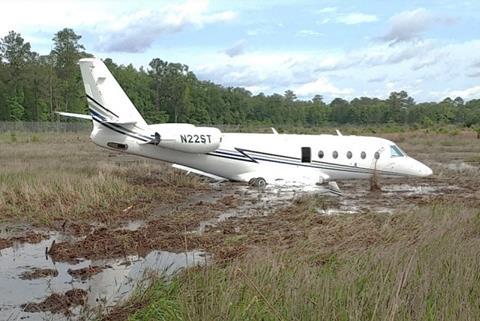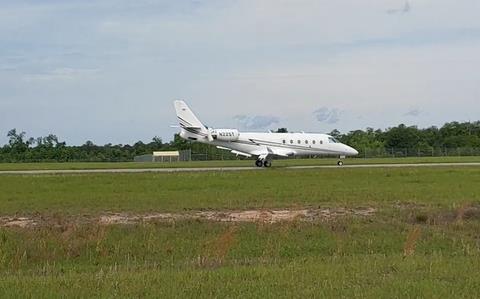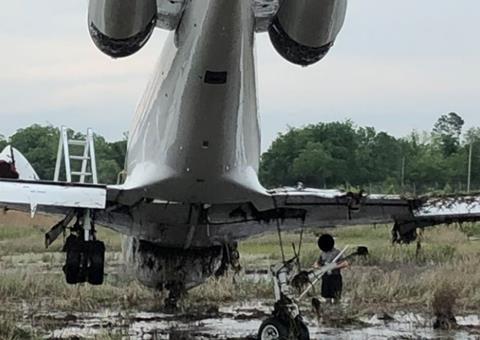US investigators have revealed the pilots of a Gulfstream G150 acted as if they were engaged in a race to beat another aircraft to their destination, before an unstable approach at excessive speed resulted in an overrun that badly damaged the jet.
The aircraft (N22ST) was heading for Ridgeland in South Carolina on 5 May 2021 following a departure from New Smyrna Beach airport in Florida.
According to the National Transportation Safety Board, about 6min after take-off one of the three passengers had asked about the estimated arrival time.
“I’ll speed up,” the captain told them. “I’ll go real fast here.”
Cockpit-voice recorder information shows that, shortly afterwards, the captain told the co-pilot that he was “already lettin’ it roll”, to which the co-pilot responded that they were flying at 300kt at 9,000ft.

The crew had noted that another jet was likely to arrive at Ridgeland ahead of the G150, despite the efforts to increase speed, and the pilots sought a direct routing from the controller.
“Anything’s going to help at this point,” the captain told the co-pilot, who stated: “That’s all we can do here, we’re going 330 [kts] and direct to the destination.”
As the aircraft climbed, the captain noted that the other aircraft was still scheduled to arrive 2min earlier, but pointed out that its crew would decelerate to 250kt below 10,000ft – adding: “And we won’t.”
“We know what we’re doing right now, we’re trying to win a race,” he said. The co-pilot agreed, before the captain remarked, in reference to stock-car racing, “This is NASCAR”, prompting laughter.
After being cleared to level at 21,000ft the captain described how one of the passengers “liked to challenge” him as to how fast they could reach the destination.
“How fast can you go? How fast can you get there?” the captain added. “But that’s the name of the game. That’s the reason you own a jet.”
Investigators have disclosed that, about 4min later, as the aircraft started descending, an overspeed alarm sounded in the cockpit, to which the captain responded: “Goal achieved.”
The overspeed alarm sounded several more times as the aircraft conducted a straight-in approach to Ridgeland airport’s runway 36.

After hearing that the G150 would arrive ahead of the other inbound aircraft, the captain “expressed excitement” and informed the passengers, says the inquiry.
When the co-pilot asked whether S-turns might be needed, after the autopilot was disengaged, the captain indicated this was not necessary. At 900ft above ground, and 1.5nm from the threshold, the aircraft was flying at 170kt – according to a call-out from the co-pilot – compared with the approach reference speed of 121kt.
Several ‘sink rate’ warnings were heard in the cockpit, as well as a ‘pull up’ alert, but the crew persisted with the approach.
Analysis of the approach showed the aircraft was landing in a quartering tailwind of 10-15kt, which exceeded the manufacturer’s limitation. The jet touched down 1,000ft along the 4,200ft runway.
Video evidence showed the aircraft’s thrust-reversers deployed shortly after touchdown while tyre marks indicated that braking occurred throughout the ground roll and increased heavily, as the anti-skid system activated, in the last 1,500ft of runway.
“We are not stopping,” the captain exclaimed, and the co-pilot replied: “No, we’re not.”

The aircraft overran the runway end by 400ft, coming to rest in wet marshland and suffering substantial damage to its fuselage and wings. None of the five occupants was injured.
After the accident, the captain stated that the aircraft had landed at about 120-128kt, and claimed: “We did not have brakes, no thrust-reversers and no ground air-brakes.”
Investigators found that the thrust-reversers and brakes activated, but the automatic ground air-brake system did not. Although the right-hand thrust lever indicated abnormal electrical behaviour from a microswitch, the inquiry could not ultimately determine the reason for the absent air-braking.
Without the air-brakes, the ground roll upon landing exceeded the runway available from the G150’s touchdown point, while the tailwind would have further increased the roll distance.





























